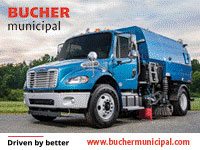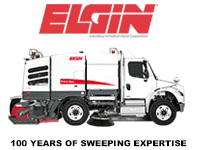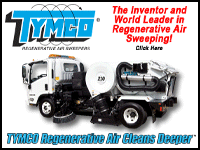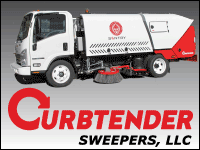Street Sweeping: On the Road to Gaining the Value it Deserves
by Ranger Kidwell-Ross, editor
WorldSweeper.com
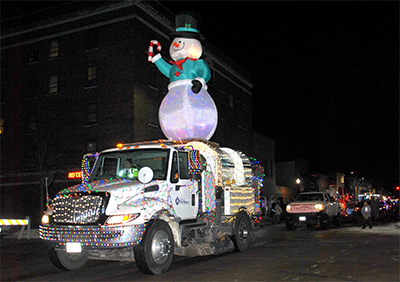
The sweeper photo above, adorned with a snowman, was featured in the recent Christmas Parade in Faribault, MN. The Faribault Public Works Department has no doubt realized the positive value in having people recognize its street sweepers in a positive situation.
The same may be said of the City of San Diego, which developed a 'Name the Sweeper' contest for its new Dulevo mini-electric sweeper. The contest garnered over 300 different name suggestions. After winnowing to three, the public chose their favorite. The machine was on display for the first time last weekend at the City's December Day event, where an estimated 300,000+ will see it. Festooned as it is with an environmentally-themed blue wrap, the intent is to teach the public about the enormous value sweeping brings to their community's urban environment.
These are just two examples of many in the current movement toward showcasing sweepers to residents. Public Works departments everywhere are starting to realize the enormous cost-effective benefits of street sweeping when it comes to pollutant removal, something citizens need to be apprised of. That message couldn't be clearer in my give-and-take interview with one of the top U.S. stormwater professionals, which is our lead article this issue. It is a compelling argument for why street sweeping needs to insert itself ever more firmly into the minds of the stormwater community.
Minnesota is joining Florida, with New Hampshire on the horizon, in providing needed stormwater crediting to municipalities. Many, if not most, jurisdictions around the U.S. aren't currently meeting their stormwater permit requirements. The above-mentioned state officials have proven to their satisfaction that street sweeping is – by far – the most cost-effective way to remove pavement-based pollutants like phosphorus, nitrogen and others. The new statewide programs essentially pay the cities in their jurisdiction an amount based on the pounds of debris removed from their streets.
Randy Neprash also argues that the sweeper manufacturers and major suppliers need to combine forces in order to advance this kind of information nationwide. I, too, encourage that to happen, and have agreed to reach out to those companies in that regard. Pavement sweeping is finally getting the recognition it has long deserved but hadn't yet proven – and now it has. Once the word gets out, I predict the next chapter in sweeping history will spawn a vastly expanded sweeper marketplace.
As we find ourselves approaching the end of another year... If you are one of WorldSweeper.com's advertising sponsors, thank you for the critical part you play in supporting 'Earth's Largest Power Sweeping Resource.'SM I am honored by your collective votes of confidence in what this organization provides to the power sweeping industry.
Likewise, if you are one of the industry suppliers providing WSA Members with savings on your goods and services, thank you for providing those WSA Member Benefits. Finally, if you sell to the sweeping industry but don't yet advertise with us, please consider doing so.
Good Sweeping,

Editor, WorldSweeper.com
Executive Director, World Sweeping Association
Member, PAVEMENT Hall of Fame
PS If you're a contractor I urge you to check out the many benefits of membership in the World Sweeping Association. Also, if you haven't 'liked' our WorldSweeper Facebook page, what are you waiting for? That's where we offer a variety of industry previews and updates on an ongoing basis.
December Newsletter Contents
(Scroll down to read stories or click on links below.)
- Minnesota Moves Forward on Credits for Street Sweeping
- Victory Sweepers Announces New UNO Single-Engine Parking Lot Sweeper
- And the Winner (of San Diego's Sweeper Naming Contest) is...
- Microplastics From Tires, Roads are Entering Waterways
- How to Diagnose Fleets' Biggest Aftertreatment Headaches
- Enhanced Sweeping Program in Forest Lake, MN, Pays Off Big
Minnesota Moves Forward on Credits for Street Sweeping

Among other titles, Randy Neprash is Vice-Chair of the National Municipal Stormwater Alliance. In this wide-ranging interview conducted by WorldSweeper's Editor, Ranger Kidwell-Ross, Neprash and Kidwell-Ross discuss the latest in study results showing street sweeping to be orders of magnitude better for pollutant removal than the next best method, catch basin cleaning.
Studies confirm "the cost-effectiveness of removing phosphorous through street sweeping is breathtakingly low, on the order of, at some times through the year, less than $100/pound. That compares to thousands of dollars a pound for various other stormwater practices." Read about how Minnesota and New Hampshire are moving to join Florida in providing street sweeping credits for their permitted cities.
As a result, stormwater credits and new funding streams for sweepers are opening up as states recognize "the extraordinary water quality improvement function" of street sweepers.
Check out the groundbreaking information.
Victory Sweepers Announces New UNO Single-Engine Parking Lot Sweeper
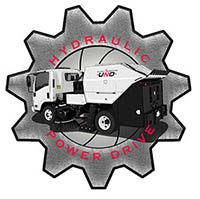
When it comes to single-engine parking lot sweepers few would dispute that Nite-Hawk is the leading provider. Now, the management of Victory Sweepers is confident it will be changing that narrative. After completing an extensive testing process the company feels its single-engine machine will be more than competitive.
According to Mark Schwarze, Victory's Sales and Marketing Director, a significant difference offered by the UNO is that the airflow pickup intake is on the driver's side of the UNO, rather than on the passenger side. Schwarze cites several other differences – all of which Victory feels are improvements – in the UNO design.
For one, Victory has gone to a mixed CAN bus and analog control panel. That means if or when a switch fails it can just be replaced rather than having to change out the entire, more expensive, CAN bus control unit. The hydraulic pump has also been moved to a different location than over the engine manifold, which Victory cites as being an area that is much more likely to cause a fire in the event of a catastrophic hydraulic failure. A complete overview is at the link below.
Check out Victory's new single-engine sweeper.
And the Winner (of San Diego's Sweeper Naming Contest) is...
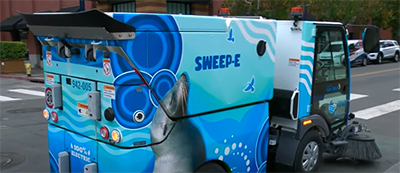
As reported in our City of San Diego feature article last month, when the City purchased a new electric Dulevo sweeper for bike lanes and similar, it held a contest for naming the unit. The contest was designed to involve citizens of the area in understanding the importance of sweeping for stormwater runoff by helping them identify with the sweeper itself. Part of the project was to give the mini sweeper an environmental, ocean-themed wrap.
City management deemed the project an outstanding success when over 300 names were submitted. After whittling the number down to three, residents were invited to go online to vote. Sweep-E's first job – and display opportunity – is scheduled for San Diego's annual December Night celebration where over 300,000 people are expected.
Check out a brief YouTube video announcing the winner and the reasoning behind naming the sweeper.
Microplastics From Tires, Roads are Entering Waterways

 An article in the October issue of STORMWATER MANAGEMENT showcases new research from the University of British Colombia – Okanogan (UBCO) that suggests an increasing amount of microplastics from tires and roadways are ending up in lakes and streams. The findings suggest that more than 50 tons of tire and road wear particles are released into waterways annually in areas like the Okanogan, which includes the eastern side of Washington State and the Canadian province of British Columbia.
An article in the October issue of STORMWATER MANAGEMENT showcases new research from the University of British Colombia – Okanogan (UBCO) that suggests an increasing amount of microplastics from tires and roadways are ending up in lakes and streams. The findings suggest that more than 50 tons of tire and road wear particles are released into waterways annually in areas like the Okanogan, which includes the eastern side of Washington State and the Canadian province of British Columbia.
Although this analysis focused on a small section of highway in the BC interior, the findings suggest that other regions across Canada may experience the same challenges with this type of contamination. And, of course, similar results would then likely be found in the U.S. and elsewhere. The results of the study indicate that almost 15 tons of tire and road wear particles can be transmitted to lake surface water each year.
The information provided includes a link to the actual study.
Check out the information.
How to Diagnose Fleets' Biggest Aftertreatment Headaches

Aftertreatment systems are responsible for some of the most common faults found on sweeper chassis and problems with the systems can result in unplanned downtime if they aren't addressed.
Aftertreatment systems have evolved a lot since their inception, yet still create headaches for the industry. This article written by FleetOwner's Mindy Long details how the right balance of diagnostics and best practices can relieve that stress and promote uptime.
Check out the best practices for your diesel aftertreatment system.
Enhanced Sweeping Program in Forest Lake, MN, Pays Off Big
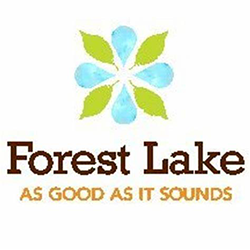
The City of Forest Lake, MN, received a Watershed Champion Award for its enhanced street sweeping program, which was developed to reduce urban stormwater pollution. In 2017, a clean water fund grant was received to help Forest Lake develop a street sweeping plan, utilizing cutting-edge research from the University of Minnesota.
Subsequently, the city secured a second Clean Water Fund grant to purchase a regenerative air vacuum sweeper and begin implementing the plan. Since then, the city has collected enough sediment and organic debris to keep 309 pounds per year of phosphorus out of Forest, Shields, Keewahtin, Comfort, and Clear Lakes. For perspective, that's enough to prevent a whopping 154,500 pounds of algae in the City's lakes!
|
